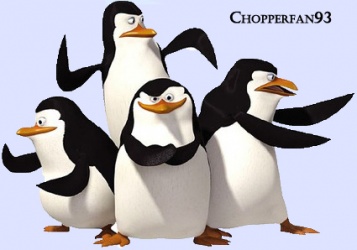Καλωσήλθατε στο .aNiMe//GR!
Αν συναντήσετε οποιοδήποτε πρόβλημα κατά την εγγραφή σας ή με την πρόσβαση σας στο forum, παρακαλούμε μην διστάσετε να επικοινωνήσετε μαζί μας.

Anime και ο περίγυρός σας
#751

Posted 07 July 2010 - 01:07
Επί του θέματος επιφυλάσσομαι να απαντήσω σύντομα (κυρίως για να ελέγξω αν έχω ήδη απαντήσει).
#752

Posted 07 July 2010 - 01:20
Necroquoting much?
Επί του θέματος επιφυλάσσομαι να απαντήσω σύντομα (κυρίως για να ελέγξω αν έχω ήδη απαντήσει).
No,i don't necroquoting.
#753

Posted 07 July 2010 - 02:45
Το τί έχω φάει ειδικά για τα anime... Εκτός του ότι, ενώ εβλεπα από μόμολο που λεει ο λόγος, έμαθα ότι είναι ιαπωνικά και έβλεπα πιο ψαγμένα στην έκτη δημοτικού. Τί το'θελα ν'αρχίσω να μιλάω γι'αυτά; Το τί bullying τράβηξα σ'όλο το γυμνάσιο γι'αυτά δε λέγεται! Σε σημείο που να με δείχνουν με το δάχτυλο και παιδιά από τα άλλα γυμνάσια σε φάση 'το καθυστερημένο με τα παιδικά'.
Οι γονείς μου βέβαια άλλο καπέλο. Κατηγορούσαν την κολλητή μου που μου τα έμαθε, κι επειδή έμενε σε άλλη πόλη έλεγαν ότι κι αυτή γελάει πίσω από την πλάτη μου κι ότι καλά θα κάνω να ξεκολλήσω και ν'αρχίσω να ζω στον πραγματικό κόσμο, γιατί δεν είναι όλα YuGiOh & Digimon. Όταν δε άρχισα να κάνω practise στα πρώτα μου ιαπωνικά μόνη μου στη Β γυμνασίου, με τα τραγούδια από τα Final Fantasy & Kingdom Hearts, εκεί να δεις. Σκοτωμός. Επειδή δεν έιχα κι άλλο τρόπο να δείξω τί ακριβώς μου αρέσει, όλοι μας δεν έχουμε γράψει στις τσάντες του σχολείου; Ε, το έκανα κι εγώ. Και όταν έβαφα τ νύχια μου σχεδίαζα τη σημαία της ιαπωνίας. Εκείνη τη χρονιά, την άτιμη την 23 Μαρτίου που πήραμε ελέχγους, ο μπαμπάς μου μου απαγόρεψε να βγαίνω/παίζω PS/βλέπω anime και μου πέταξε ό,τι είχα και δεν είχα, διαγράφοντας κ το Login μου στο μοναδικό PC που είχαμε τότε. Σ'εκείνο το τρίμηνο είχα ανεβάσει το γενικό μέσο όρο μου αλλά από 11 είχα 10 στα μαθηματικά, κι έγινε θηρίο. Κι όχι τ'anime έφταιγαν, και πολύ αέρα μου είχαν δώσει, και, και και. Δεν μπορώ να καταλάβω όμως η αδελφή μου, που έχει το ίδιο μικρόβιο, γιατί ποτέ δεν έγινε περίγελος, ποτέ δεν της φέρθηκαν άσχημα οι γονείς μας γι'αυτό...
Όμως χαίρομαι που παρ'όλ'αυτά, όσο δυστυχισμένη κι αν ήμουν, όταν τελείωσα την 3η γυμνασίου έψαχνα στον pathfinder τα καινούρια προφίλ για να δω αν υπάρχουν άλλοι ανιμόφιλοι, κι έτσι βρήκα την κοπέλα που τώρα είναι κολλητή μου. Από τότε έχουν επεκταθεί οι γνώσεις μου, είδα εκατοντάδες anime, διάβασα πάρα πολλά manga, ασχολούμαι με τη μουσική τους και την τηλεόρασή τους γενικά, βλέπω τις διερές που βγαίνουν [the doramas] κάθε season σε raw και προτιμώ οτιδήποτε κι αν κάνω να έχει σχέση με την ιαπωνία. Το πιο ευτυχές γεγονός; Εχουμε φτάσει σε σημείο η μόνη unrelated παρέα μου να είναι δυο κοπέλες που κάνω παρέα στο πανεπιστήμιο. Η μαμά μου ποτέ δεν είχε αντίρρήσεις, μέχρι που πριν καναδυο χρόνια όταν ήταν έγκυος έβλεπε μαζί μας Rurouni Kenshin που το είχε στο μακεδονίαtv. Τώρα πια ο μπαμπάς μας βγάζει αφίσες στον μεγάλο εκτυπωτή στη δουλειά του, μας άνοιξε και λογαριασμό για Online shopping κι εγώ με τη μικρή έχουμε γεμίσει το δωμάτιό μας με manga, βιβλία σχετικά με την ιαπωνία, περιοδικά και photobook ιαπώνων καλλιτεχνών, και καταφέραμε τον μπαμπά να αφήσει τη μικρή να κάνει μαθήματα, μιας που εγώ διαβάζω μόνη μου.
Τα συμπεράσματα δικά σας. Ήμουν πολύ ηλίθια που έδειχνα με κάθε τρόπο το ότι είχα αυτό το συγκεκριμένο ενδιαφέρον; Τώρα δεν μπορώ να φανταστώ τον εαυτό μου χωρίς εκείνα τα χρόνια, όσο κι αν δεν θα τα ευχόμουν ούτε στο χειρότερο εχθρό μου. Όλες μου οι παρέες τώρα είναι ανιμόφιλοι, και δεν με νοιάζει καθόλου που ακόμα και τώρα, μετά από όλο αυτό, dad still sees me as something infected and unclean. Όταν θα τελειώσ με το πανεπιστήμιο κ θα πάω να ζήσω ιαπωνία θα δούμε ποιός θα είναι δυστυχισμένος τότε *sigh*
#754

Posted 07 July 2010 - 18:56
Άσε που πολλοί πέσαμε πάνω στον όρο anime ψάχνοντας για σειρές που βλέπαμε μικροί.
Αναζήτηση λόγω νοσταλγίας δηλαδή και όχι για κάτι "καινούργιο".
σε αυτο φαινεται να συμφωνουν και καποιοι Ιαπωνες (διαβασε παρακατω)
Όταν θα τελειώσ με το πανεπιστήμιο κ θα πάω να ζήσω ιαπωνία θα δούμε ποιός θα είναι δυστυχισμένος τότε *sigh*
αλλοι ομως αφηνουν την ιαπωνια και ερχονται στην Ευρωπη
http://www.filmschool.cz/en/show.php?kat=9
Jun Nito from Shizuoka, Japan
2nd-year student in Animation
I came to Film School Zlin because I wanted to follow my dream.
That dream was to study puppet animation, a technique not widely utilized in his native country. And so, after completing a Bachelor's Degree in Marketing at Hukui University in Japan, Jun decided to move to Czech Republic so that he could learn this animation technique from the people who know it best. The Czechs have long been considered world leaders of this particular animation method that combines stop-motion cinematography with the manipulation of custom-made, three-dimensional puppets.
The animation studios in Zlιn maintain a unique position in the history of Czech animation. The first Czech puppet film Ferda the Ant was made here in 1944 by Hermιna Tyrlova. Later, Tyrlova collaborated with another famous Czech animator, Karel Zeman, to create Vánocní sen (The Christmas Dream) at the Zlin Studios. This film, which uses a combination of real actors and animated puppets, won Best Animated Film at Cannes in 1946. It was the remarkable work of Tyrlova and Zeman that inspired Jun to moves thousands of miles from his native Japan to study at Film School Zlin. Studying here gives him the opportunity to make his own animated films in the same studios where these esteemed Czech animators once worked.
Jun was also inspired by another Czech animator Bretislav Pojar. Pojar's well-known series Pojďte pane, budeme si hrát (Come Sir, let's play) is considered to be the most successful Czech puppet series ever made. This playful story about two bear brothers, was created using an animation technique called 'puppet relief' or 'poloplast'. This method, which is a variation of traditional puppet animation, uses two-dimensional puppets and is shot from a vertical, rather than horizontal perspective.
At the end of his first year at Film School Zlin, Jun completed his own animation project 'Friends' employing this 'poloplast' animation technique. His two-minute film features a rabbit, elephant and monkey who encounter some helpful giraffes while playing football in the jungle. Last year he assisted another Japanese student, Naoko, on her Absolvenska (Graduation) film 'Tokyo Brothers'. ?During three months I made many of the backgrounds for this puppet film ' sky, fields and mountains ' and did a little bit of the animation.
Jun has really enjoyed his time in the Czech Republic. Zlin is a peaceful place and nature is all around. The beer is not bad either. The Czech people really know how to enjoy life.
What's his next dream? To start his own studio of puppet animation.
#755

Posted 15 July 2010 - 20:14
#756

Posted 15 July 2010 - 20:36
#757

Posted 15 July 2010 - 21:45
Οι γονεις μου η δεν εχουν παρει χαμπαρι οτι εδω και 2 χρονια βλεπω η απλα δεν τους νοιαζει,η παρεα μου δεν εχει κανενα προβλημα γιατι οι μισοι απο αυτην βλεπουνε επισης animes και ολος ο υπολοιπος κοσμος δεν το εχει αναφερει καν αν και ειμαι γνωστος δεκτης καζουρας στο σχολειο.:bahhh:It's so difficult to have a normal life...

#758

Posted 15 July 2010 - 22:24
H σχέση των δικών μου με τα anime..!! - Οι γονείς μου δεν έχουν ιδιαίτερο πρόβλημα (thank God:joyful:), αλλά όταν με βλέπουν να καίγομαι ώρες μπροστά από την οθόνη, τότε πετάνε ατάκες του στυλ "χάνεις την ώρα σου" "πώς κόλλησες έτσι μ' αυτά'' κλπ... Το πιο εκνευριστικό όμως είναι πως όταν στην παρέα μιλάω για αυτά, ολοι εκτός από 2-3 που βλέπουν, με κοιτάνε λες και έχω έρθει από άλλη διάσταση..... Στην αρχή με ενοχλούσε, αλλά τώρα πια σκέφτομαι ότι έχω βρεί κάτι που με κάνει χαρούμενη, μια παραπάνω ασχολία και έχω έρθει σε επαφή με μια κουλτούρα που κανείς από όλους αυτούς τους άσχετους, που κράζουν εμάς τους anime-lovers δεν ξέρει....
Δυστηχως η γενια σας δεν προλαβε τη χρυση εποχη των ανιμε (και των κινουμενων σχεδιων γενικα) στην ελλαδα, ειτε απο τα καναλια ειτε απο τα βιντεοκλαμπ ( ποκεμον,γιουγκιοχ και ντιγκιμον δυστηχως δεν αρκουν) με αποτελεσμα ειτε να μην εχουν ιδεα, ειτε να ναρουτοποιηθουν και να βλεπουν μονο αυτο ή η αισθητικη τους να αλλοιωθει απο τα απειρα τρισδιαστατα.
Απο μας δεν υπαρχει ατομο που να μην ξερει ανιμε οπως χαρλοκ, καντυ,σαντυμπελ,τζουμαρου κλπ.
Ετσι αναγκαστικα καταφευγουμε στα φανσαμπς που επειδη ειναι τοσα πολλα δεν μπορεις να βρεις κατι κοινο να συζητησεις
#759

Posted 16 July 2010 - 11:20
Αδερφή: Οκ, η μικρή μου αδερφή είναι περιπτωσάρα. Από τη μία βρίζει όλους τους χαρακτήρες από τα ανιμε που βλέπω (ειδικά Sakura & Sasuke) και τρέφει μια μικρή συμπάθεια προς την Orihime και την Ino, αλλά από την άλλη δείχνει να της αρέσουν τα ανιμε γενικότερα. Μια μέρα άρχισα να της εξηγώ για τα ανιμε και έδειξε μεγάλη προσήλωση (τόση μάλιστα που την επόμενη άρχισε να κάνει μαθήματα σε μια φίλη της- έρμο κoριτσάκι) και από τότε για κάθε τι που βρίσκει με ανιμέ στον υπολογιστή θα με ενημερώνει. Παρ' όλα αυτά βρίζει όποιο χαρακτήρα δεν πάει και τους βγάζει σαρκαστικά ονόματα (πχ. ένα που θυμάμαι ήταν που έλεγε την Sakura, Αγγούρω). Μάλιστα, έχει κι ένα συμμαθητή που βλέπει ανιμε λόγω του bro του και παραλίγο να μαλώσουν επειδή του άρεσαν χαρακτήρες που δεν πήγαινε αυτή.
Φίλοι:
* Κολλητές: Μια από τις κολλητές μου είναι serious otaku (το όνειρό μου είναι να γίνω μια μέρα σαν κι αυτή
*Λοιποί φίλοι: Έχω και φίλους που βλέπουν ανιμε, αλλά και τέτοιους που ούτε καν ξέρουν τι είναι. Αυτοί που δεν ξέρουν, δεν ξέρουν και γενικά πως εγώ βλέπω ανιμε, γιατί ποιος κάθεται να εξηγεί πάλι
Συμμαθητές: Οι περισσότεροι στην τάξη μου βλέπουν ανιμε, οπότε δεν έχω πρόβλημα. Μάλιστα με την οτάκου κολλητή μου τους έχουμε βγάλει και ονόματα. Το θέμα είναι όμως πως καμιά φορά το παρακάνουμε (ειδικά εγώ) με τα ανιμε και μας φωνάζουνε καμμένα.
Wanna-be-boyfriend: Ξέρει πως βλέπω ανιμε και διαβάζω μάνγκα και δεν δείχνει να έχει πρόβλημα, παρ' όλα αυτά με λέει για πλάκα καμμένο. Εδώ αντί να με καληνυχτήσει πετάει: "Α! Και Δήμητρα, μη δεις πολύ Naruto και σε πειράξει".
#760

Posted 16 July 2010 - 11:28
Would like to see what happens in case you discover yaoi/shounen ai.Wanna-be-boyfriend: Ξέρει πως βλέπω ανιμε και διαβάζω μάνγκα και δεν δείχνει να έχει πρόβλημα, παρ' όλα αυτά με λέει για πλάκα καμμένο. Εδώ αντί να με καληνυχτήσει πετάει: "Α! Και Δήμητρα, μη δεις πολύ Naruto και σε πειράξει".
ΌτανΑν τα φτιάξουμε είναι θέμα χρόνου να τον κολλήσω οξεία ανιμείαση, and then he' s gonna be my bitch:hehehe:.
#761

Posted 16 July 2010 - 11:34
Εγώ δεν έχω κανενα πρόβλημα με αυτά (guilty pleasureee:kill4u:). Αυτός έτσι και πει τίποτα, θα τον ευνουχήσωWould like to see what happens in case you discover yaoi/shounen ai.
#762

Posted 16 July 2010 - 11:34

Ιδού η Black Hole, ιδού και το πήδημα.

#763

Posted 16 July 2010 - 14:11
...έτσι σκέφτηκα, αλλά τελικά δεν έχω κάτι να πω...
Μερικές φορές απλά μου λένε να σταματήσω να χρησιμοποιώ references από ταινίες (anime included) γιατί δεν αντιλαμβάνονται τι προσπαθώ να πω.
Κατά τ' άλλα, ανάλογα με το άτομο, μπορεί να έχει μερικό ως ελάχιστο ενδιαφέρον για το τι είναι "άνιμε".
Αλλά τουλάχιστον έβαλα την ξαδέρφη μου την μικρή στον κόσμο των manga. Τώρα θέλει να δανείζεται τους τόμους που διαβάζω. Και το δανείζειν δεν είναι το καλύτερο μου.
#764

Posted 16 July 2010 - 20:55
Η μανα μου κανει κατι βηματα με το deathnote manga αν και ακομα ψιλο θεωρει τα περισσοτερα anime παιδικα η γελοια(επεσε και πανω στην στιγμη full metal 2 spoiler
Οι φιλοι δυστηχως βλεπουν κυριως ναρουτο,bleach,one piece και δεν εχουν σε μεγαλη υπολοιψη τις σειρες που βλεπω κυριως το(deathnote,full metal) αλλα υπαρχουν και εξαιρεσεις με μερικους αλλους που εχουμε ιδιες προτιμησεις.

#765

Posted 16 July 2010 - 21:22
Δεν υπαρχει ετσι κανενα δεσιμο και γινεται κατι ψυχρο και απομακρο.
Θα μου πεις πλεον δεν υπαρχουν και επιλογες αλλα χαιρομαι που προλαβα την αναλογικη εποχη.


















